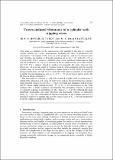Vortex-induced vibrations of a cylinder with tripping wires
Author(s)
Hover, F.S.; Tvedt, H.; Triantafyllou, M.S.
DownloadTriantafyllou_2001_Vortex.pdf (601.8Kb)
Terms of use
Metadata
Show full item recordAbstract
Thin wires are attached on the outer surface and parallel to the axis of a smooth
circular cylinder in a steady cross-stream, modelling the effect of protrusions and
attachments. The impact of the wires on wake properties, and vortex-induced loads
and vibration are studied at Reynolds numbers up to 4.6 X 10^4, with 3.0 X 10^4 as
a focus point. For a stationary cylinder, wires cause significant reductions in drag
and lift coefficients as well as an increase in the Strouhal number to a value around
0.25-0.27. For a cylinder forced to oscillate harmonically, the main observed wire
effects are: (a) an earlier onset of frequency lock-in, when compared with the smooth
cylinder case; (b) at moderate amplitude/cylinder diameter (A=D) ratios (0.2 and 0.5),
changes in the phase of wake velocity and of lift with respect to motion are translated
to higher forcing frequencies, and (c) at A=D = 1:0, no excitation region exists; the
lift force is always dissipative.
The flow-induced response of a flexibly mounted cylinder with attached wires is
significantly altered as well, even far away from lock-in. Parameterizing the response
using nominal reduced velocity Vrn = U/fnD, we found that frequency lock-in occurs
and lift phase angles change through 180deg at Vrn=4.9; anemometry in the wake
confirms that a mode transition accompanies this premature lock-in. A plateau
of constant response is established in the range Vrn = 5.1-6.0, reducing the peak
amplitude moderately, and then vibrations are drastically reduced or eliminated
above Vrn = 6.0. The vortex-induced vibration response of the cylinder with wires is
extremely sensitive to angular bias near the critical value of Vrn = 6.0, and moderately
so in the regime of suppressed vibration.
Date issued
2001Department
Massachusetts Institute of Technology. Department of Mechanical EngineeringPublisher
Cambridge University Press
Citation
Journal of Fluid Mechanics, 448, p.175-195 (2001)
Keywords
vortex-induced, reynolds number